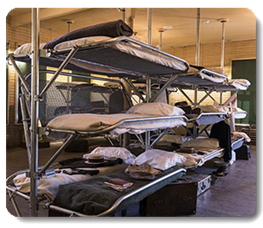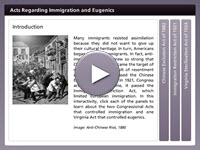Immigration
Immigration to the United States
 In the latter half of the Nineteenth Century, industry in the United States was booming. The railroad connected the East Coast and West Coast, and major cities experienced rapid urbanization. Cities had jobs available in textile and steel mills, along with a variety of other factory labor. The Midwest and West required laborers to farm and mine. In Europe and Asia, many people faced poor economic conditions and religious oppression. These citizens saw America as the land of opportunity. In this interactivity, explore why Europeans and Asians migrated to America during the Nineteenth and early Twentieth Centuries. Click the player button to begin.
In the latter half of the Nineteenth Century, industry in the United States was booming. The railroad connected the East Coast and West Coast, and major cities experienced rapid urbanization. Cities had jobs available in textile and steel mills, along with a variety of other factory labor. The Midwest and West required laborers to farm and mine. In Europe and Asia, many people faced poor economic conditions and religious oppression. These citizens saw America as the land of opportunity. In this interactivity, explore why Europeans and Asians migrated to America during the Nineteenth and early Twentieth Centuries. Click the player button to begin.
View a printable version of the interactivity.
Ellis Island
 Would you travel to another country in search of a better life? What if the journey was dangerous? What if you knew you would have to work hard and live in harsh conditions? From 1892 until 1954, all immigrants arriving from Europe had to pass through inspection at Ellis Island, New York. During this time, nearly 12 million immigrants entered the United States. Once the immigrants passed through Ellis Island, they were free to attain religious freedom and economic opportunity. Click the player button to begin.
Would you travel to another country in search of a better life? What if the journey was dangerous? What if you knew you would have to work hard and live in harsh conditions? From 1892 until 1954, all immigrants arriving from Europe had to pass through inspection at Ellis Island, New York. During this time, nearly 12 million immigrants entered the United States. Once the immigrants passed through Ellis Island, they were free to attain religious freedom and economic opportunity. Click the player button to begin.
View a printable version of the interactivity.
Angel Island

Baracks at Angel Island Immigration Station
While Ellis Island controlled immigration on the East Coast, another inspection station was needed on the West Coast. Starting in 1910 and ending in 1940, Chinese and Japanese immigrants were detained and inspected at Angel Island immigration station. Angel Island was located in San Francisco Bay, California.
At Angel Island, men and women were housed separately. Immigrants here could be detained for weeks or months. There are some reports of Chinese immigrants spending an entire year at Angel Island. While being detained, the immigrants were interrogated and then sent back to the barracks. The barrack walls were covered with carved poetry and messages. The Chinese were held in detention due to the Chinese Inclusion Act of 1882. It is estimated that one million Chinese immigrants entered the United States through Angel Island before a fire destroyed the building in 1940.
Assimilation
 With high amounts of immigration, the United States became a “melting pot.” The phrase melting pot refers to the mixing of people from different cultures and races. Overtime, immigrants abandoned their native languages and cultures and assimilated, or became Americanized. In this interactivity, learn what it meant to assimilate into American culture during the late Nineteenth and early Twentieth Centuries. Click the player button to begin.
With high amounts of immigration, the United States became a “melting pot.” The phrase melting pot refers to the mixing of people from different cultures and races. Overtime, immigrants abandoned their native languages and cultures and assimilated, or became Americanized. In this interactivity, learn what it meant to assimilate into American culture during the late Nineteenth and early Twentieth Centuries. Click the player button to begin.
View a printable version of the interactivity.
Political Machines
During this era in the United States, political machines were in operation. These were groups of people that worked to get their leaders elected to government offices. Then those elected leaders would use their position of power to help others in the group by hiring or appointing them to different government positions. Political machines maintained their power through bribes and voter intimidation. Immigrants were often exploited by these political machines who provided services to the immigrants in exchange for their votes of support at election times. This practice increased the animosity that natural Americans felt towards these new immigrants. The political corruption that came with political machines not only hurt new immigrants, it also would eventually contribute towards the Progressive Movement.
Acts Regarding Immigration and Eugenics
 Immigrants made invaluable contributions to the building of America, but were not treated fairly as citizens. Any immigrant coming to America during this time period was likely to face hardship and hostility. Americans discriminated against immigrants based on religion and culture. In addition, Americans feared immigrants would work for lower wages and longer hours. These mounting resentments led Congress to control the amount of people immigrating in the United States. In this interactivity, learn about the Chinese Exclusion Act of 1882 and the Immigration Restriction Act of 1921. Click the player button to begin.
Immigrants made invaluable contributions to the building of America, but were not treated fairly as citizens. Any immigrant coming to America during this time period was likely to face hardship and hostility. Americans discriminated against immigrants based on religion and culture. In addition, Americans feared immigrants would work for lower wages and longer hours. These mounting resentments led Congress to control the amount of people immigrating in the United States. In this interactivity, learn about the Chinese Exclusion Act of 1882 and the Immigration Restriction Act of 1921. Click the player button to begin.
View a printable version of the interactivity.
History of Chinese Immigration to the United States
![]() Chinese immigrants fulfilled labor needs that were important to the building of the transcontinental railroad. Initially, the immigrants were welcomed into the United States. As time progressed, the Chinese were feared by Americans because they were willing to work for long hours and low pay. The Chinese were viewed as exotic and dangerous. This led Congress to exclude any Chinese immigrant through the Chinese Exclusion Act of 1882. Watch History of Chinese Immigration to the United States from eMediaVASM to learn about Chinese Immigration and the Chinese Exclusion Act.
Chinese immigrants fulfilled labor needs that were important to the building of the transcontinental railroad. Initially, the immigrants were welcomed into the United States. As time progressed, the Chinese were feared by Americans because they were willing to work for long hours and low pay. The Chinese were viewed as exotic and dangerous. This led Congress to exclude any Chinese immigrant through the Chinese Exclusion Act of 1882. Watch History of Chinese Immigration to the United States from eMediaVASM to learn about Chinese Immigration and the Chinese Exclusion Act.
Immigration Review
![]()
 Now that you have explored immigration, complete this activity to check your knowledge. Click the player button to get started.
Now that you have explored immigration, complete this activity to check your knowledge. Click the player button to get started.